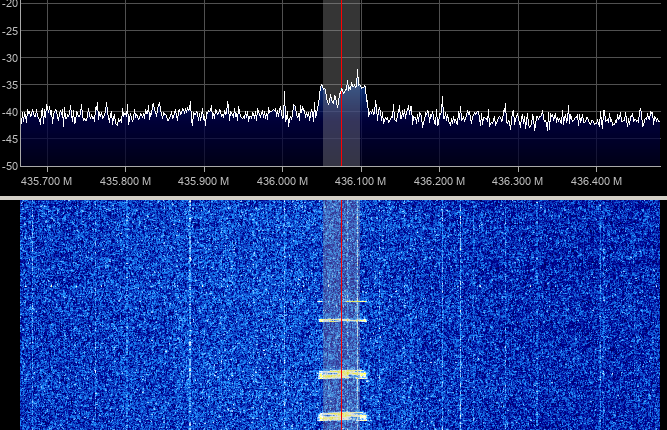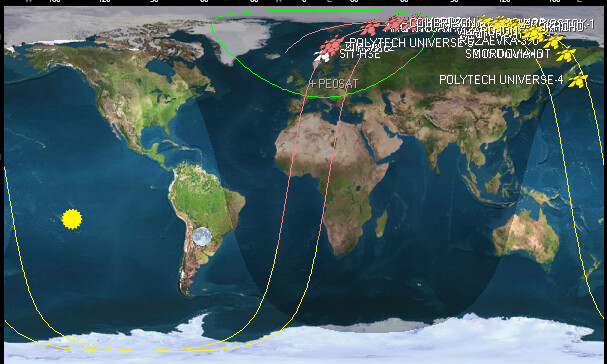ASRTU-1
1 99130U 24312.00767361 .00029170 00000-0 12462-2 0 00003
2 99130 097.3825 176.7911 0016208 232.3616 135.7334 15.22798387000019
After reviewing yesterday’s wide-spectrum recording, I wanted to investigate obvious signals that were not easily matched to an object already identified.
The signals up around 437.900 caught my eye, so after reversing the LoRa parameters I left an Arduino/LoRa device listening during this morning’s pass. A decode was recovered:
… looking at the list of objects w/ their suspected frequencies I guess this is either MORDOVIA-IOT (437.865) or RUZAEVKA-390 (437.865)
An inadvrtant decode of RUZAEVKA-390 (99194) RS44S during a ZIMSAT-2 observation ](SatNOGS Network - Observation 10533850) using @PE0SAT’s gr_satellite ZIMSAT-2 (original version) yaml. ![]()
ASRTU-1 Update
ASRTU-1
1 99130U 24312.68981482 .00008607 00000-0 36734-3 0 00000
2 99130 097.3826 177.4620 0016213 230.2545 275.0464 15.22842314000011
Did you also see this wide signal in your recording ?

My best guess, one of the new CSTP satellites with Lora on 436.075 and also one on 436.550
No - thanks for pointing those out.
Shown below, I had 125k LoRa signals loud in my waterfall at 436.250 but nothing down below 436.100 or just above 435.500.
I’ll watch for those!
-Scott
Some TLE update
RTU MIREA1
1 98894U 24312.53000000 .00000000 00000-0 50000-4 0 00
2 98894 97.4000 175.3132 0012212 116.5769 230.5791 15.20985231 08
Colibri-S
1 98794U 24312.81000000 .00000000 00000-0 50000-4 0 00
2 98794 97.4000 172.2709 0007877 187.6187 265.4517 15.25669108 07
Horizon
1 98793U 24312.81000000 .00000000 00000-0 50000-4 0 09
2 98793 97.4000 176.3227 0009285 268.8013 184.7277 15.19529351 05
TUSUR GO
1 98788U 24312.85000000 .00000000 00000-0 50000-4 0 07
2 98788 97.4000 174.6627 0012369 123.2800 175.7900 15.23898165 09
VIZARD-ion
1 98789U 24311.76000000 .00000000 00000-0 50000-4 0 07
2 98789 97.4000 176.8087 0010388 198.9938 259.2118 15.20343518 07
There are these LoRa satellites from this launch
Polytech Universe 4 - 437.785 MHz
Polytech Universe 5 - 437.885 MHz
Vladivostok-1 436.805 MHz
CSTP2.1 - 437.485 MHz
CSTP2.2 - 437.050 MHz
CSTP2.11 - 437.985 MHz
Norby-3 - 436.570 MHz
Updated TLE for SamSat-Ionosphere:
SamSat-Ionosphere
1 98786U 24312.75499531 .00000000 00000-0 00000-0 0 00006
2 98786 097.2680 177.3395 0039589 216.4141 284.9577 15.22680076000009
Thanks for the TLE sets, all added in DB and updated in Network.
I need last update TLE for kosar satellite and this is so important for me. i cant find and track kosar.please give me information if you can.
and also i see good attitude for kosar that tracked in one station in satNOGS.
i need more details and more information if some one can guide me i can share my real coding and configs for kosar .
Hey, Niya! Welcome to our community!
Could you please give an example of signal from Kosar satellite? How does it look? IQ file would be perfect.
Does it look something like on this observation? SatNOGS Network - Observation 10519852
[quote=“niya, post:92, topic:11468, full:true”]
I need last update TLE for kosar satellite and this is so important for me. i cant find and track kosar.please give me information if you can.
and also i see good attitude for kosar that tracked in one station in satNOGS.
i need more details and more information if some one can guide me i can share my real coding and configs for kosar .
[fredy]
Hi @niya as @geoscan noted we have some signals that could be Kosar, but we need confirmation to be 100% sure.
First can you confirm the two frequencies(436.838 MHz and 436.750 MHz) that we track are the ones expected for the satellite to transmit on them?
Second, we have some signals at the second one (436.750 MHz) but they are different:
One is like this SatNOGS Network - Observation 10539216
and the other like this SatNOGS Network - Observation 10518640
Can you confirm if any of them or both belong to Kosar?
I can confirm that frequencies of 436.75 and 436.74 are expected for kosar satellite to transmit on them.
there is some specification of our signal in both carrier frequency: 1-our modulation is 2FSK with frequency deviation around 4.8KHZ and 2- our signal bandwidth is around 18.75KHZ. 3-our transmission is in burst mode 1 minute transmit and 5 minute stand mode.( in your spectrometery i can see some mismatch with our transmission duration).
I went over multiple passes when the satellite should be over Europe, but no signals found.

Is the satellite always transmitting 1 minute/5 minute intervals or only over specific areas?
Here an example from 11-07-2024 21:00 UTC center freq 436.750 Mhz
And also 436.740 MHz
Jan - PE0SAT
Three more questions:
-
Have you received any signal from the satellite until now?
-
Is the satellite transmitting worldwide or only over specific areas?
-
What happens if the power of the satellite isn’t enough for 1min burst transmission?
I checked again the observations in Network and I have found 3 that may be Kosar:
-
SatNOGS Network - Observation 10533819 In this one there is transmission around 400-460sec. Which is around 18.75KHz wide. Also maybe there is some signal around 100sec which confirms the 5min gap. However the pass is low and at the same time another station with higher pass doesn’t have any signal SatNOGS Network - Observation 10533822
-
SatNOGS Network - Observation 10518635 In this observation there are two signals at 200sec and 500sec, so 5min gap and the signal is also wide. However we don’t have the 1min transmission
-
SatNOGS Network - Observation 10519861 This is one of the first observations near the deployment time, there is signal at 200sec and faint signal at 500sec. These signal are also wide and the duration is close to 1min
Let us know if any of the above looks like Kosar.
Looking at the 5 GEOSCAN satellites (51, 59, 67, 68 and 78), you won’t be able to decode them using UZ7HO’s High-Speed SoundModem for GEOSCAN, not even with version 0.02b.
Currently, gr-satellites users be able to decode it after an update as PE0SAT already mentioned.
A few decodes:
RS51S to BEACON 2024-11-07 21:14:52 UTC
84 8a 82 86 9e 9c 60 a4 a6 6a 62 a6 00 e1 03 f0 01 00 00 00 00 00 00 00 00 00 00 00 00 00 00 00 00 00 00 00 00 00 00 00 00 00 00 00 00 00 00 00 00 00 00 00 00 00 00 00 03 96 20 54 00 8d 7f 00 12 62 01 00 06 00 00 00
.
RS67S to BEACON 2024-11-08 19:13:01 UTC
84 8A 82 86 9E 9C 60 A4 A6 6C 6E A6 00 E1 03 F0 01 00 00 00 00 00 00 00 00 00 00 00 00 00 00 00 00 00 00 00 00 00 00 00 00 00 00 00 00 00 00 00 00 00 00 00 00 00 00 00 03 FE 20 29 00 91 7F 00 0C B2 01 00 0A 00 00 00
.
RS78S to BEACON 2024-11-08 19:16:41 UTC
84 8A 82 86 9E 9C 60 A4 A6 6E 70 A6 00 E1 03 F0 01 00 00 00 00 00 00 00 00 00 00 00 00 00 00 00 00 00 00 00 00 00 00 00 00 00 00 00 00 00 00 00 00 00 00 00 00 00 00 00 03 96 20 26 00 92 9B 09 29 1B 01 00 0C 00 00 00
The frame size is variable with the new GEOSCAN deframer used by the newly launched satellites.
COLIBRI-S as an example.
name: COLIBRI-S
alternative_names:
- RS67S
norad: 98794
data:
&tlm Telemetry:
unknown
transmitters:
9k6 FSK downlink:
frequency: 436.835e+6
modulation: FSK
baudrate: 9600
framing: GEOSCAN
frame size: 74
data:
- *tlm
Hello again and good day
About your questions:
1-since launch we received data for few times over gs
2-the satellite transmission pattern is repeated all over the world
3- if satellite doesn’t have required power, transmission is completely cancelled.
And about tree observation reports:
IN these observation exist some detected packet as our expectations but in other hand there is some mismatch in 10533819 and some other spectrum result, can you confirm shape of our carrier spectrum based on 2FSK
modulation?
Can you confirm the received Bw is around 18.75khz?






